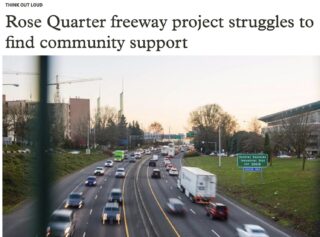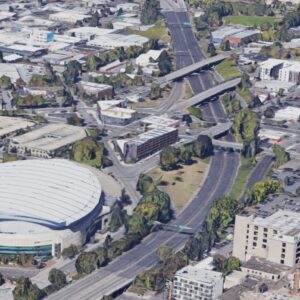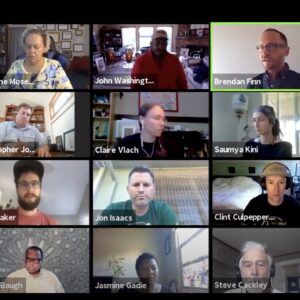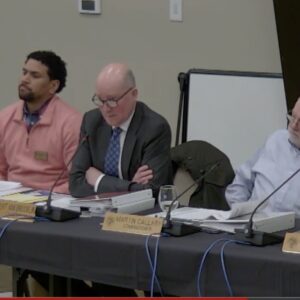
The Oregon Department of Transportation has made a new promise regarding their controversial I-5 Rose Quarter project.
Asked Friday by the host of Oregon Public Broadcasting’s Think Out Loud radio show about how much power the forthcoming Historic Albina Advisory Board (HAAB) would have to influence the project, ODOT’s Director of Urban Mobility Brendan Finn said they’d have, “A tremendous amount of power and influence in how this project shapes out. They’re going to help reshape it with us.”
Finn was a guest on the show along with Oregon Walks‘ Claire Vlach and John Washington, CEO of Flossin Media, and the chair of the Soul District Business Association — both of whom were members of the I-5 project’s Citizen Advisory Committee which was abruptly disbanded earlier this month.
ODOT shut down the committee after just three meetings and the agency said it will be replaced by a new one that aims to, “intentionally center Black voices”. On September 14th a majority of committee members (including Vlach) signed a letter accusing of ODOT of silencing their voices due to fears they were too critical of the agency’s plan to widen I-5.
It’s widely assumed ODOT shut the committee down before a mass resignation turned into yet another PR debacle. ODOT has already been reprimanded by Governor Kate Brown for their mishandling of the environmental review process and has seen nearly every local power player — including Winta Yohannes with Albina Vision Trust, Portland Mayor Ted Wheeler, City Commissioner Chloe Eudaly, County Commissioner Jessica Vega Pederson and others — walk away from the project.
Think Out Loud host Dave Miller asked about the problems with the old committee and why we should expect the new one to be any different.

(Photo: City of Portland)
Former committee member Claire Vlach told Miller she felt like ODOT wasn’t listening to them at the meetings, “Especially when we asked to talk about parts of the project that we thought were really important — namely, the expansion part,” Vlach said. “When we mentioned that, we were told that that was something that we had no say over. That the project was being built no matter what.”
“Why was that [the freeway expansion] off the table?” Miller then asked ODOT’s Finn.
“Well, as the you know, the project is still pretty much in its infancy,” Finn said, while not directly addressing the question. He then went on to say ODOT is merely carrying out the legislature’s orders because the project was earmarked in the 2017 transportation funding package (legislators voted to address congestion on I-5 through the Rose Quarter, they didn’t prescribe a specific solution).
Advertisement
Then Finn went on about how ODOT is “ready to do things differently” and “ready to be deliberative about our our commitment to our shared values around restorative justice.”

(Photo: ODOT)
“Why disband the committee after just three meetings?” Miller interjected.
“By elevating the voices of those that have historic ties to that neighborhood, we’re now taking action…” Finn replied.
“Some of the people who represented the Albina neighborhood — whose homes or family homes were destroyed [by construction of I-5] — they were on the advisory committee that you have now disbanded,” Miller said in response. “So, essentially, you’re saying, ‘We’re going to elevate the voices of Black people who’ve been harmed by this; but we’re going to do that partly by disbanding a committee that includes many of these voices.'”
Finn countered that the new committee they’ll form in place of old one will be made up entirely of Black people with ties to the Albina neighborhood — not just, “What we’ve done in the past, where we just have one representative seat, or two or three.”

(Photo: Flossin Media)
One of those voices is likely to be Washington. He’s made it clear he wants to hold ODOT accountable but he hasn’t been as critical of the agency as others on the committee. He also didn’t sign onto the September 14th letter.
Asked by Miller whether or not he would trust ODOT’s new direction on the project, Washington said, “That’s like asking me, ‘How am I gonna’ trust the man?'” Washington then voiced concerns that the old committee, “Didn’t have any teeth.” “We simply want to slow the process down a little bit, so that we can begin to talk about the things that are really crucial for us to move this project along,” he continued. “And where we can… can get some benefit out of this that we believe is part of restorative justice… We just don’t want to see no more damage done. And we want to get some upsides in this situation.”
Miller then asked Finn how much power the new committee would have. Finn tried to dodge the question at first, but Miller pressed him with a follow-up. “If they say we want ‘x’, will you do ‘x’? Or will you say, ‘We listened to you, thanks for your input, but we’re going to do ‘y’?'”
Then Finn made the promise: “I think, [the new committee will have] a tremendous amount of power and influence in how this project shapes out. They’re going to help reshape it with us and with our contractor. We’re going to figure it out, we’re early enough on that we have plenty of time to do it. So I think I just answered it. I guess significant, incredibly significant.”
What form the new committee takes — and how or if they reshape this project — is something we’ll be watching very closely.
Listen to the full show on OPB here.
— Jonathan Maus: (503) 706-8804, @jonathan_maus on Twitter and jonathan@bikeportland.org
— Get our headlines delivered to your inbox.
— Support this independent community media outlet with a one-time contribution or monthly subscription.







Thanks for reading.
BikePortland has served this community with independent community journalism since 2005. We rely on subscriptions from readers like you to survive. Your financial support is vital in keeping this valuable resource alive and well.
Please subscribe today to strengthen and expand our work.
The new committee that they will be filling with whatever sycophants they can find is going to have tremendous power? Give me a break…
It is very important to include black voices from the community that was damaged by the highway in the 50’s and 60’s. It does not seem adequate to have a committee made up exclusively from that committee. The effects of the pollution, and transportation disruption will effect all the communities adjacent to the rose quarter. The effects of climate change and the financial costs will be a statewide burden. And ODOT should not be able to hand-pick the committee; after so many missteps the governor should appoint them. This seems like trading one version of misrepresentation from another.
Just FYI there are Black people who are from the neighborhood AND who care about – and are capable of – representing climate/bike/walk/transit etc concerns.
That is a fair assumption, although I think that there is more than one neighborhood that will be directly impacted. A diverse set of concerns and neighborhoods COULD be represented by black representatives, but ODOT is currently saying that the selection criteria to be on the advisory committee are 1) Black and 2) historic ties to the neighborhood. I want ODOT to commit to including people who explicitly represent climate concerns, alternative transportation concerns, Harriet Tubman Middle School, each neighborhood adjacent to the impact area, air quality, etc. I do not doubt that these representatives could all be Black, but I do not trust ODOT to insure that the broad range of concerns of the neighborhoods and Portland will be represented. The way ODOT has framed how they they will select committee members implies they are going to seek out members of Black community who will directly benefit from the proposed project and call that community representation and restorative justice.
oh i’m not going to defend ODOT’s plans or intentions at all. absolutely not. You make very important points.
I just didn’t want people to assume that being Black and having climate/transpo knowledge/connections are mutually exclusive.
Going to be interesting to see how this plays out.
Tremendous power, incredibly significant, no one has ever seen power like this before.
I just re-listened to this segment and was impressed by how effectively John Washington communicated. I can see why ODOT didn’t want him on the committee! Washington seems very direct and focused on the harmful impacts. Meanwhile Finn (ODOT), is basically lying about how developed the project is (it is farther along than he is implying), and ODOT’s willingness to ‘recreate a neighborhood’; this project further divides the neighborhood (removes Flint) and adds nothing meaningful in return- the lids will not support buildings and will be unpleasant and unsuited to park programming.
I appreciate that Finn is talking about congestion pricing, but if they have any commitment to fighting climate change, they should enact congestion pricing first, then evaluate the need for this project. Or they could just close the ramps to/from Broadway.
Basically, we delayed and bloated the projected to $800 million. And now we just watched the OTC adopt the premise that congestion pricing money would go to the corridor. So now ODOT is lining up their funding mechanisms to pay for the 3 auxiliary lanes in HB2017 which specifically states auxiliary lane (thanks Garret) with congestion pricing and not HB 2017 money which already already has too many hands in the pot. So now congestion pricing isn’t an equity tool, it’s a funding tool for the proliferation of the freeway industrial complex. And Brendan Finn pretty much spends his ODOT salary time lobbying state elected officials that he’s just smart enough to make this work (he’s not, it won’t). He likes to buddy buddy man up with the Lew Frederick legislative staff. It’s like Black patriarchy on steroids with a lot of purple flashy bling bling on the state coffers. Stay Purple!
Lipstick on a pig?
Classic DOT tactic: Say it’s still too early to be concerned with design issues until it’s too late to change them.
Yup. Finn’s a nice guy, went to planning school with him and a bunch of others, but now you need to talk with the design engineers – the real deciders.
They should spend all $500 million on capping all of I-5 in the NE with buildable land and building brand new, world class bike and pedestrian infrastructure throughout. THAT would restore the fabric of the community and be an extremely valuable project.
The problem with capping, even ignoring the expense, is that all the exhaust is vented over the cap. The pollution will still hover over the neighborhood – except for whatever is picked up by the wind and shared with the rest of Portland.
Surely there are smart, modern ways of filtering the vents to minimize toxic air? I have no idea. Just guessing. Maybe not.
I suppose the thesis of my point is that if the money “must” be spent, perhaps it would be prudent for the new committee to consider demanding something good be built instead, rather than the project be scrapped entirely. $500 mil could build safe streets with bike and pedestrian infrastructure that Amsterdam can only dream of!
I think fairness dictates that the pollutants be biofiltered through the lungs of the people wearing cars.
Valid point…a lot will depend on how soon OR (and WA) businesses convert to EV trucks for delivery or shift to rail / water. There will still be heavy metals management (air and water) from brake linings etc.
An idea from 20 years ago when this was proposed back then: put a turbine on a vent to capture lost energy, then use that energy to power scrubbers to remove the toxins, like on the chimneys on the pulp plant in Albany Oregon.
Having a committee made up solely of people who had some connection to a section of the I-5 corridor 60-70 years ago and also pass a racial litmus test seems like an odd criteria to serve on a committee designed to advise on a highway project with some regional significance (as ODOT claims). At the very least, the committee should be made up of current residents, but even that doesn’t seem to really capture the diversity of people who would be impacted by this project.
In this case, I’m with the cynics who think ODOT is hoping for a more compliant bunch in the second round. And if they’re choosing the committee with that in mind, they might get it.
Or maybe they could have a committee made up of residents from around the state who periodically drive through the area on the way to a Seahawks game? (Oh wait, they already have that, don’t they – it’s called the Oregon State Legislature…)
If they won’t have the power to kill the project, then they won’t have enough power. Having watched this thing for over 10 years, that is the only power that matters
Why not make all north-south I-5 traffic go thru downtown via I-405
(those not taking I-84 or using another exit between)
This should be a long-term goal for our region. This would facilitate the removal of the east bank freeway and Marquam bridge. Add more capacity to I-405 and I-205 and keep the cars off of our waterfront.
I agree, Chris. I-5 was built in the wrong location and should now be moved west and take over the I-405 / Hwy 30 alignment, crossing the Columbia near St Helen’s. It’ll give Columbia County a nice economic boost and also return much valuable real estate to Portland. The bridge to Vancouver will become a local lift bridge with rail, cycling, and walking facilities; the I-5 Columbia crossing near St Helen’s can have 24 lanes and be as tall as it needs to be w/o impacting PDX approaches.
This is the future – you read it here first. 🙂
I am not disagreeing that the waterfront is a bad place for a freeway. But that’s a very short stretch of road that is mostly industrial. In the Albina District, four neighborhoods bound the 1-5 corridor; Loyd Dist, Elliot, Boise, Humbolt. Boise and Humbolt are north of the 405 merge and they are very densely populated. Whereas Loyd and Elliot are mostly businesses with sparse residential zones. In short, that wouldn’t really address pollution for the Albina District. Not to say it wouldn’t be nice to get our waterfront back.
You left off the Overlook neighborhood.
https://www.portlandoregon.gov/civic/48708
Well, my geography may be skewed. I did find this though; Inner N/NE Portland (which includes Alameda, Boise, Concordia, Eliot, Grant Park, Humbolt, Irvington, King, Sabin, Sulivan’s Gulch, Vernon, and Woodlawn neighborhoods), which is historically referred to as Albina or the Albina neighborhood (Albina included all the neighborhoods mentioned above minus Vernon, Sulivan’s Gulch, Alemeda, Grant Park, and Concordia), is an area of particular importance to the African American community in Portland.
roughly one-third of the residents adjacent to I-5 (across the highway from Boise and Humboldt neighborhoods)live in the Overlook neighborhoood. I hope they find someone to represent those people.
Maybe that’s why it’s named that.
Better yet, completely remove I-5 between the Fremont Bridge and John’s Landing, along with I-405 on the south side of downtown. Through traffic would cross at the Fremont bridge, go through the tunnels, and then go down Hwy 217. It would only add about 4 minutes for through traffic. Truly regional through traffic would be redirected to I-205.
It’s not as crazy as it sounds. The tunnels are a choke point due to all the merging. Under this scenario there would just be one way to go–a lot less decision making.
As someone else noted, this does leave the section of highway through the Rose Quarter, since I-84 will still need to be connected. Sections probably could be capped though, especially since it would remain at its current width.
Or you could close the freeways altogether and build grand boulevards in their place. The traffic volumes would be the same, but at least adjacent businesses could benefit from all the customers passing by.
(I’m not the originator of this idea – it comes from “The Boulevard Book” by Allen Jacobs, Elizabeth Macdonald, & Yodan Rofe, 2002.)
Another option, suggested by the late Steve Iwata of PBOT a 15 years ago, is to make 405 and I-5 one-way, as a very large 4-mile diameter counter-clockwise roundabout. Nothing new would need to be built, but several ramps would need to be closed off and access reduced; on the other hand, several counter lanes then could be opened up for bike-only or transit-only use.
Still a good idea!
Yes, as long as you’re not directly impacted by all the increased traffic you’d be shoving onto I-405 (and the associated side streets via interchanges), then this is a wonderful idea.